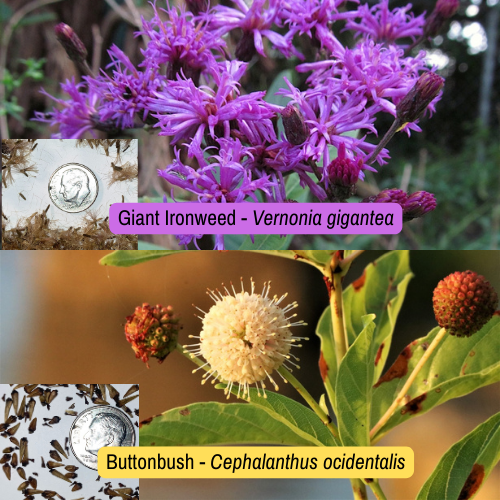Bienvenue
et Joyeux Carnaval
If you made it to this page you probably got a packet of seeds from me in Krewe Bohème! I have spent the last year collecting these seeds by hand all around Southeastern Louisiana. Many of them went into producing plants for a small native plant nursery I am developing. The rest are now in your hands, ready to be planted. On this page you can learn more about which seed packet you received, Swamp or Prairie, and how to germinate and care for each plant. I hope watching these seeds grow will bring you as much joy as in my own home. It may also be frustrating and require a lot of patience. Trust me, it is worth it. Luckily, our native plants have evolved to grow here and they will likely pop right up.
Le Marais - The Swamp
-
These seeds come from water loving species of plants, adapted to our marshes and swamps in Louisiana. If you have an area of your yard that experiences regular flooding, these plants are perfect candidates for that spot. They will take the stormwater up through their roots, reduce flooding, and turn the floodwaters into beautiful blooms.
-
Buttonbush is one of my favorite swamp plants in Louisiana. The blooms persist throughout summer, attracting tons of native pollinators. The Acadian settlers in the regions called the plant “bois de marais” meaning swamp weed. It is a hardy plant but needs plenty of water.
To germinate, bury about .25 inches deep when soils have reached at least 75 degrees Fahrenheit or with a seed starting heat mat indoors. Germination can take up to 4 weeks with this species, so patience is key. This is a lso a slower growing plant, but the payoff is worthwhile.
-
Vernonia gigantea is no joke; this plant can grow up to 12 feet tall, though it usually hangs out at 3 to 5 feet. The bright purple clusters of flowers appear from July to November, providing great late season color and food for our native pollinators. This plant will die back each winter and send up new shoots come spring.
To germinate, Vernonia gigantea seeds quire stratification (60 days cold stratification in the fridge), which I have already done for these seeds. Once soil temperatures have reached 65 degrees Fahrenheit or with a seed starting heat mat, lightly cover the seeds with 1/8” of soil and dampen. Germination should occur within 2-3 weeks.
La Prairie - The Prairie
-
These seeds come from the prairies and savannahs of Louisiana, a little farther upland from the swamps and marshes. These species can stand on their own or intermingle with tree understories. They are perfect for existing garden beds with proper drainage or areas where fussy exotic plants can’t handle the native soil!
-
Scarlet sage thrives in full sun, but can handle some shade. It blooms from the beginning of spring up to the first frost of winter, meaning there are still bright red blooms in January here in New Orleans! In addition to year round blooms this sage is incredibly drought tolerant and reseeds readily, spreading throughout the garden.
To germinate sprinkle over and gently press the seeds finely graded soil or straight into the garden, provide consistent moisture (but not too much) and sunlight. The first leaves should appear within 1-2 weeks.
-
White wild indigo prefers full sun but can handle some shade. While not closely related to the dye producing indigo plant, both species are in the Fabaceae or Legume family, and a similar dye can be derived from Baptisia alba. White Wild Indigo takes a few years to produce blooms (potentially up to 2-3 years), but when it does they are a magnet for native pollinators. Both the dried seed pods and flowers themselves make excellent cut arrangements. This species is also highly drought, insect, and poor soil tolerant!
Germination can be sporadic for this species, so Bonne Chance! When planting in containers indoors, soak the seeds in hot water overnight. If planting outdoors, late Winter to early Spring sowing is best (late February to early March). Sow seeds 0.5 inches deep. Germinations should occur within 2-3 weeks.
Further Reading
I’ve tried to provide some basic information on these plant species, but there’s always more to learn. To the right I have provided some links to my favorite resources for native plants, great for going down the rabbit hole of Gulf Coast ecology!
Maybe seeds aren’t your thing. That’s OK too.
If so, all I ask is that you share these seeds with someone who will plant and care for them. And if you still want to get your hands on some native species, Murier has it’s own nursery with these plants in stock! If you need help in your landscape, maybe with serious flooding or just with adding some native beauty, check out what we offer and schedule some time to meet with us.



